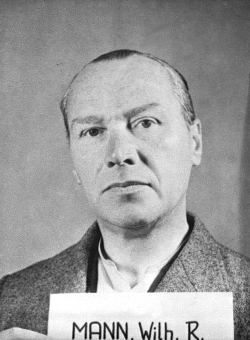Wilhelm Rudolf Mann (1894–1992)

© National Archives, Washington, DC
“Almost a decade and a half of internal strife […] were required to lead to the conviction that the parliamentary form of government, suitable for the Western countries, was incompatible with the conditions in Germany […] The difficulties which confronted the new government upon coming into office were immense […] The new Government went to work, however, without hesitation and with the greatest energy. In a few months, conditions were radically transformed [...] Peace was restored to the people and they could go about their affairs without fear for life and property.”[1]
Wilhelm Rudolf Mann, born on April 4, 1894, was the son of Rudolf and Selma (née Herrenbrück) Mann. His father first worked as a shipping agent and later became head of the pharmaceuticals department and a managing board member at Bayer and I.G. Farben. Wilhelm Mann attended school in Elberfeld and Lennep and graduated from a commercial school in Cologne in 1910. Next he did a three-year commercial apprenticeship at an iron and steel plant, Eisen- und Stahlwerk G. & J. Jäger, in Elberfeld. He served in the German Army as a one-year volunteer in 1913 and fought in World War I. In 1919, Wilhelm Mann began studying political economy in Cologne. One year later, he took a position in sales at Hoechst, where he was promoted and made an authorized signatory in the dyes department in 1922. In 1926, he was transferred to Leverkusen and trained as his father’s successor in the pharmaceuticals and pesticides department of I.G. Farben. In addition, he sat on the DEGESCH supervisory board. He married his cousin Else Herrenbrück, and after her premature death he married Gerda Liefeldt. He had two children from his first marriage.
In 1928, Wilhelm Mann was made a director, and in 1931 he followed in his father’s footsteps as an alternate member of the managing board of I.G. Farben. Moreover, he was chairman of the East Asia Committee and served as the Danish consul for the Rhineland and Westphalia. In 1931, Mann joined the NSDAP, and in 1934 he became a full member of the I.G. Farben managing board and an SA-Sturmführer
(SP; transl. KL)
















